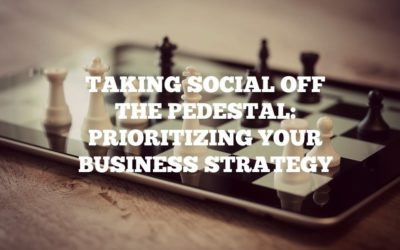The success of B2B businesses online is hidden from none. While social media was initially considered to be as the pathway to success for B2C businesses, B2B businesses have jumped on the bandwagon just as successfully and have benefitted from some amazing results.
B2B businesses are proof that almost any business from any industry can succeed on the majestic world of social media. How have they managed to do so? By turning the social world into a playground for themselves! Most B2B businesses operate in niche industries that aren’t the most captivating or aren’t the most fascinating to be part of. But with due care and extravagant creativity, these businesses have been able to make social media their own.
When one thinks of successful B2B businesses with a great social media marketing presence, a number of big names come to mind: Google, IBM, HubSpot and many others. These companies aren’t concerned with broadcasting their services or products constantly. In fact, they harness the attention of their potential audience by sharing and creating content that resonates with their interests.
B2B companies generally play on soft ground online. They have to remain nimble footed and find the middle ground between engagement and interest. By this we mean that a good B2B social media strategy should be able to engage users to create value for the brand and not disrupt their social media experience in the process. There is a fine line between engagement and self-promotion, and B2B businesses need to identify it during their marketing campaigns online.
In this article we take a detailed look at some actionable social media strategies B2B business owners can follow today. The world of B2B might sound mundane and boring, but social media offers a way for companies in the niche market to build a cool reputation in this not-so-cool segment.
1. Set SMART Goals
Like any other marketing strategy, a social media marketing strategy should also be based on goals and objectives. Setting specific and measurable goals for your business can help in identifying a social media strategy that works for your brand.
Before you identify and define your KPIs, you need to understand just what success means to your brand. Is your B2B brand approaching social media as an acquisition channel? Are you looking to enhance your reach online? Answering these questions will help you understand the metrics and the indicators to track during your time online.
For instance, if your business wants to generate leads through social media, you should be tracking clicks and conversions as possible metrics for success.
Goals you set for your B2B social media campaign should follow the SMART criteria. By SMART we mean the following acronym:
- Specific: Goals you set should be specific and should identify the possible social media platforms you want to start your strategy from. Try to cut down on options and don’t talk general.
- Measurable: The metrics you identify should be measurable and easy to track. Without a way to measure your progress or objectives, your social media campaign will probably go unnoticed.
- Attainable: Who doesn’t want to set ambitious goals? But, if you want to grow by leaps and bounds, without sending your business into a spiral of disappointments, then it is necessary for you to set attainable goals.
- Relevant: The goal should be also relevant to the objectives you have set for your brand. This again can be made easier through a better understanding and identification of your social media metrics and KPIs.
- Time Bound: It is best to set a time specific limit on the period you want to achieve your goals in. Without a specific time limit you’d end up chasing these goals without proper measurement or progress.
With a set of SMART goals and strategies, you can follow and achieve the success you want for your B2B business online.
2. Focus on Competitors
Nothing is hidden on social media today. While marketing campaigns never were secretive, social media opens the doors on how your competitors communicate with their audience and the content sharing and interaction strategy they have.
Larger B2B companies will want to keep tabs on their competitor’s strategy in a bid to determine the progress they’re making. If you have a small target audience, you can take influence from a successful social media campaign by a competitor and reinvent their strategy with a spin of your own.
Keeping a tab on your competitor’s social media strategy isn’t all about copying their strategies or noticing their trends. In fact, being involved allows you to see news, trends and events that your competitor has missed out. Gain a competitive advantage over them by communicating in ways that they aren’t doing right now. In short, you don’t just follow your competitors to be influenced, but you also do so to initiate campaigns they haven’t had a sniff of yet.
3. Be Original
Many businesses kick start their social media campaign by curating and copying content from somewhere else. Your audience is pretty clever at recognizing posts that you have actually created as a result of your own creativity or posts that you’ve just copied from somewhere else to remain busy or active on a given day.
Users online want original content, and if you’re spinning content from different sources then they won’t spare you their time. Original content has a certain appeal, which works to rope in interest from users.
It is better to scale down a bit if you’re having trouble concocting original and creative content every day. Spend more time on channels and social media platforms where your audience participates in, and give them the kind of content they’re accustomed to seeing.
4. Incorporate Multimedia in Your Campaigns
We’re shocked at just how many organizations have dumped multimedia sharing options due to the relative casualness they carry. Instagram stories, LinkedIn documents and Twitter polls aren’t just for the young ones to play with. In fact, B2B businesses can also incorporate multimedia in their marketing campaigns to add the X-factor.
Adding multimedia to your online posts will not only help generate your audience’s attention, but it will also keep them hooked to what you post. Identify the importance of multimedia through your own social media experience.
What if you only saw text-based posts on Twitter and other social media? Wouldn’t that be boring? Social media is popular and addictive today because of how every tweet and post happens to be different from the next one. Even during a 10-second stroll of your social media feed you’ll come across a meme, a poll, a gif, a text post and a photo collage. This is what keeps social media exciting and natural. Do not steal that natural oomph from the platforms you operate on.
5. Focus on Your Employees
We might be mentioning this a little late in our list, but mentioning and focusing on your employees is one of the best strategies for B2B businesses to remain relevant online. Many B2B companies do this successfully today. Highlighting your employees allows your audience to put faces alongside your company name and also personalize the brand as one that really does value the work done by employees.
Highlighting your employees on social media is an increasingly efficient way of employer branding. Employer branding is a marketing strategy through which you increase an employee’s advocacy online and give them the ability to spread positive word-of-mouth about your workplace. Showcasing staff members also increases the engagement generated by content. Employees tend to share photos and posts they’re mentioned in by their employer. For instance, instead of posting the interface of a new software solution you’ve devised for a client, try posting a group picture of the 20 staff members that were behind the project. All 20 of your staff members will share this picture to their feed and will lead to further engagement.
Finally, focusing on your employees also has the added advantage of improving employee morale. Employees feel better at work and since they’re recognized for their work and contribution, they happen to give their best during the time to come. This is just the kind of morale and confidence you would like to build within employees inside your place of work.
6. Have a Distinguished Voice
Every blog you share on your website and every post you put on your social media gives you a unique chance to demonstrate and build upon your brand voice. Just like a customer can recognize your brand from its logo, you should strive to help customers recognize your brand voice as well. Like all different types of marketing content, whatever you post on your social media should always be aligned to your company’s perspective and voice.
For B2B businesses, it is highly necessary that they build a brand voice that differentiates them from others in the market and helps cement their reputation. Companies like Wendy’s and Burger King are just a few examples of organizations with a consistent brand voice online.
7. Offer Support
There are times when all your audience needs is some support. No one wants to see a B2B brand ignore customer support service issues highlighted on their social media. Customer service is of high importance in the B2B world, and prospective customers are extremely particular on the kind of support they get from a provider.
If your current social media pages are inundated with negative reviews from disgruntled customers, and you haven’t done anything to address them, then you’re potentially losing out on a number of sales opportunities. Always respond to customers when they post a complaint on your social media. Make sure that you address their reservations and find a solution, even if you don’t have a separate handle for complains.
8. Be Consistent
B2B businesses will agree that one of the hardest parts about being active on social media is maintaining consistency. Posting creative stuff on different channels on a regular basis can be mentally tasking and takes a lot of time and effort. Not only do you have to put your head in the game, but also have to make sure that all minor and major irregularities are taken care of.
You can also maintain consistency by creating a publishing calendar than you follow to the letter. This will help you streamline objectives and track metrics as well.
9. Experiment with Posting Times
This is a step most brands should take after setting up a consistent posting schedule. Every audience is different in nature, which is why you should experiment with different posting times. There are endless posting experiments you can run to enhance results. Some of these ideas include:
- Test different positions to place conversion link
- Alternative between statistics and questions to see the engagement on both posts
- Add emojis to enhance engagement
- Post less frequently
- Post more frequently
- Post in the evenings during peak traffic hours
- Use different hashtags on different posts and see how people react
These experiments can help break the monotony and give you and your team something to track and work on in the future.
10. Engage in Conversation
This is one strategy that holds true for both B2B and B2C businesses. At the end of the day you should be able to engage with your target audience and get the results you expect from them. Talk to them; discuss issues and present solutions when you can.
Winning on social media can be tough for B2B businesses, but with slow and gradual process businesses can achieve the results they desire. With the tips and strategies we have mentioned here you can kick start your B2B market campaign and take it to further glory.








0 Comments